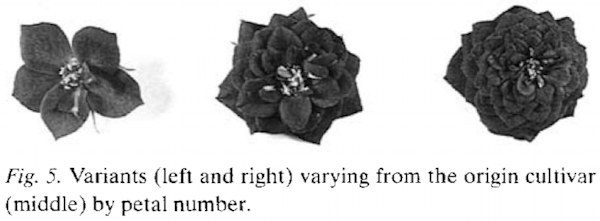In my reading about intergeneric crosses, I came across what may be tricks to try in wide crosses within the rose family.
The first is based on the following paper:
Title: Pollen tube growth and early embryogenesis in wheat x maize crosses influenced by 2,4-D
Author: Wedzony, Maria; Van Lammeren, Andre A. M.
Authors affiliation: Dep. Plant Physiology, Polish Academy Sci., Slawkowska 17, 31-016 Krakow, Poland.
Published on: Annals of Botany (London), volumn 77, pages 639-647, (1996).
Abstract: " Pollen tube growth and embryogenesis were investigated in the intergeneric Triticum aestivum times Zea mays cross. Emasculated wheat florets were pollinated with maize pollen, and at one day after pollination, the wheat plants were injected with 2,4-dichlorophenoxyacetic acid (2,4-D). The influence of 2,4-D on pollen tube behaviour was determined applying callose staining in whole mount preparations of pistils. Changes in the embryo sac and early embryogenesis were analysed on sections after various histochemical stainings. Maize pollen tubes germinated within 30 min and grew much slower through the pollen tube pathway compared with selfings of both maize and wheat. Deviations in pollen tube growth occurred such as coiling, widening and forking, irrespective of treatment with 2,4-D. Pollen tubes reached the micropyle between 5 and 24 h after pollination. 2,4-D treatment increased the number of the pollen tubes that reached the micropyle, and additionally, multiplication of sperm cells was found in the maize pollen tubes. Embryo formation was analysed at 2 d after pollination. Only when pollen tubes were in the micropyle, zygotes and embryos were observed. This points to their hybrid origin. Moreover, the embryos are likely of zygotic origin since multicellular embryos exhibited micronuclei, a sign of chromosome elimination not occurring in parthenogenic embryos and leading to haploidy of the embryos. Treatment with 2,4-D increased successful intergeneric fertilization from 18.7 to 69.3%. Immature embryos were rescued by in vitro culture from 14% of pollinated florets when excised at 14 d after pollination."
My comments: a 1 ml syringe was used to inject 1 ml of a 100 mg 2,4-D per liter of solution into the stem cavity of the highest internode. My question is: will this introducing 2,4-D result in the plant eventually dying? They removed the embryos after 14 days in order to culture in a petri dish; so, I assume the plants were still living then. If that amount of 2,4-D would eventually kill the plant, is there a chemical that could used several days after the injection of the 2,4-D in order to save the plant (such as GA3) and allow the hips to form normally?
